OUR LADY OF GOOD HELP
OUR LADY OF GOOD HELP TIMELINE
1831 (January 30): Marie Adele Joseph Brise was born in Dion-le-Val, Brabant, Belgium.
1855: Brise and her family emigrated from Belgium to Wisconsin.
1859 (October): Brise had three visions of the Virgin Mary in which she was told to teach
children about God.
1859: Brise’s father built the first shrine chapel on the apparition site.
1867: The first school, St. Mary’s Academy, was built at the chapel site; the school formally opened in 1869.
1871 (October 8): Brise led a prayer vigil around the chapel during the Peshtigo fire. All five acres of the chapel grounds were unharmed while the surrounding land was destroyed.
1896 (July 5): Adele Brise died.
1933: The School was remodeled into the Home for Crippled Children.
1941: The current chapel building was constructed.
1953: The Home for Crippled Children was closed and Pre-Novitiate High School was established.
1968: The high school was closed. Franciscan Sisters continued to manage the shrine
1970: The grounds became a House of Prayer.
1992-2002: The Carmelite Sisters from Grand Rapids, Michigan assumed responsibility for the shrine.
2002: The local diocese reassumed control of the shrine.
2009 (January 9): Bishop David Ricken appointed a commission to study Brise’s original apparition claims.
2010 (December 8): The site was authenticated and was the first to be recognized by the Roman Catholic Church in the United States.
FOUNDER/GROUP HISTORY
Marie Adele Joseph Brise was born to Lambert and Marie Brise in Dion-le-Val, Brabant, Belgium on January 30, 1831. As a child she
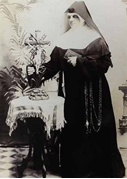 and several friends pledged to join a religious order. However, Brise continued to live with her parents in what was a relatively poor family until 1855 when the family emigrated to America. The family purchased a 240 acre tract of land to support itself. It was four years later, in October, 1859, just a short time after the Marian apparitions at Lourdes, that Brise had the first of three apparitional experiences. She was carrying grain to a mill in Champion, Wisconsin when the Virgin Mary appeared to her: “She saw a lady clothed in dazzling white, with a yellow sash around her waist and a crown of stars around her head standing between two trees, one a maple, the other a hemlock” (Shrine 2010). Brise found the experience frightening. On Sunday, October 9, the second apparitional event occurred when Brise was walking to Mass in Bay Settlement, a neighboring area, with two companions. Only Brise directly experienced the apparition. Finally, when walking home from church, Brise experienced an apparitional figure in the same place for a third and final time. Mary identified herself as the “Queen of Heaven” and told Brise that she must teach the children how to live their lives for God. From that day forward, Brise devoted her life to the teachings of the Catholic faith to young
and several friends pledged to join a religious order. However, Brise continued to live with her parents in what was a relatively poor family until 1855 when the family emigrated to America. The family purchased a 240 acre tract of land to support itself. It was four years later, in October, 1859, just a short time after the Marian apparitions at Lourdes, that Brise had the first of three apparitional experiences. She was carrying grain to a mill in Champion, Wisconsin when the Virgin Mary appeared to her: “She saw a lady clothed in dazzling white, with a yellow sash around her waist and a crown of stars around her head standing between two trees, one a maple, the other a hemlock” (Shrine 2010). Brise found the experience frightening. On Sunday, October 9, the second apparitional event occurred when Brise was walking to Mass in Bay Settlement, a neighboring area, with two companions. Only Brise directly experienced the apparition. Finally, when walking home from church, Brise experienced an apparitional figure in the same place for a third and final time. Mary identified herself as the “Queen of Heaven” and told Brise that she must teach the children how to live their lives for God. From that day forward, Brise devoted her life to the teachings of the Catholic faith to young
children. The chapel was soon accompanied by a school, St. Mary’s Academy, in 1867 (Mann 2011). Brise had gathered many pupils by this time and began teaching them at Our Lady of Good Help.
Several years after the school was built a destructive fire swept through the surrounding area. On October 8, 1871, many of the citizens and land owners in the surrounding areas sought shelter at the chapel grounds from what became known as the Peshtigo fire. These people joined Brise in a procession around the grounds of the chapel to protect them. By morning, the flames had been quenched by the rain and Our Lady of Good Help remained untouched. This was considered a miracle by many, especially considering the fact that the neighboring areas had been scorched by the flames and over 2,000 were found dead (Kasten 2010).
After Brises’ death in 1896, she was buried near the original apparition site. At that time the fate of the prayer site and school 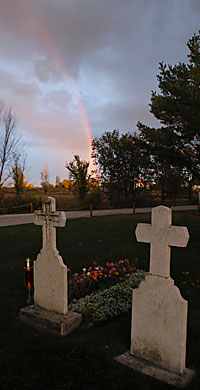 seemed uncertain. The school suffered without her presence and was passed into the hands of Sr. Pauline LaPlante, an original member of the Sisters of St. Francis of the Holy Cross of Bay Settlement (Kasten 2010). She worked to continue the school until her death in 1926 (Mann 2011). In the following years the school changed hands and faces several times. In 1933, it was remodeled as the Home for Crippled Children, and then in 1953, Bishop Paul Rhode discontinued the home and turned it into a pre-noviate high school for the Bay Settlement Sisters. In 1990, it became a House of Prayer for the Bay Settlement Sisters until 1990 when the diocese gained control of the grounds. The diocese converted the property into a shrine and welcomed in a group of Carmelite Sisters who founded the Carmel of the Holy Name of Jesus in 1992 (Kasten 2010). Ten years later the Carmel moved on to rural Denmark.
seemed uncertain. The school suffered without her presence and was passed into the hands of Sr. Pauline LaPlante, an original member of the Sisters of St. Francis of the Holy Cross of Bay Settlement (Kasten 2010). She worked to continue the school until her death in 1926 (Mann 2011). In the following years the school changed hands and faces several times. In 1933, it was remodeled as the Home for Crippled Children, and then in 1953, Bishop Paul Rhode discontinued the home and turned it into a pre-noviate high school for the Bay Settlement Sisters. In 1990, it became a House of Prayer for the Bay Settlement Sisters until 1990 when the diocese gained control of the grounds. The diocese converted the property into a shrine and welcomed in a group of Carmelite Sisters who founded the Carmel of the Holy Name of Jesus in 1992 (Kasten 2010). Ten years later the Carmel moved on to rural Denmark.
At that point in time, the Our Lady of Good Help was still important in the local community, but there was very little national or international attention. The Bishops of Green Bay supported the Shrine of Our Lady of Good Help as a place of prayer, but there had never been any formal recognition or declaration regarding the apparitions. This changed on January 9, 2009 when Bishop David Ricken opened a formal investigation into the apparitions. Less than two years later he declared that the apparitions given to Adele Brise were in fact worthy of belief and showed substance of supernatural character (Sly 2010).
DOCTRINES/BELIEFS
Adele Brise was the only visionary at Our Lady of Good Help. She reported no other visions or apparitions before or after those 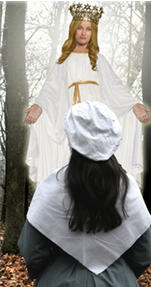 three at the site that would come to be known as Our Lady of Good Help. It was at the third apparitional event, which occurred while Brise was returning home from church that she received her spiritual mission (Shrine 2010; Kasten 2010). Brise reported that she asked the figure “In God’s name who are you and what do you want of me?” Mary reportedly then told Brise that she was the Queen of Heaven and assigned Brise a mission: “I am the Queen of Heaven who prays for the conversion of sinners, and I wish you to do the same. You received Holy Communion this morning and that is well. But you must do more. Make a general confession and offer Communion for the conversion of sinners. If they do not convert and do penance, my Son will be obliged to punish them.” Mary then offer more specific instructions: “Gather the children in this wild country and teach them what they should know for salvation.” When Brise inquired how she might accomplish this mission with little knowledge, Mary responded: “Teach them their catechism, how to sign themselves with the sign of the Cross, and how to approach the sacraments; that is what I wish you to do. Go and fear nothing. I will help you.”
three at the site that would come to be known as Our Lady of Good Help. It was at the third apparitional event, which occurred while Brise was returning home from church that she received her spiritual mission (Shrine 2010; Kasten 2010). Brise reported that she asked the figure “In God’s name who are you and what do you want of me?” Mary reportedly then told Brise that she was the Queen of Heaven and assigned Brise a mission: “I am the Queen of Heaven who prays for the conversion of sinners, and I wish you to do the same. You received Holy Communion this morning and that is well. But you must do more. Make a general confession and offer Communion for the conversion of sinners. If they do not convert and do penance, my Son will be obliged to punish them.” Mary then offer more specific instructions: “Gather the children in this wild country and teach them what they should know for salvation.” When Brise inquired how she might accomplish this mission with little knowledge, Mary responded: “Teach them their catechism, how to sign themselves with the sign of the Cross, and how to approach the sacraments; that is what I wish you to do. Go and fear nothing. I will help you.”
The religious activity at Our Lady of Good Help is rooted in Catholic doctrine. As is common with many apparition groups, the goal of this prayer site is to return to what are understood to be God’s teachings. Brise was instructed to teach children how to love and worship God. Those were her only instructions, and she followed them and sought to expand them to incorporate the entire community.
The site has come to be regarded as a place of miracles, and a steady stream of believers daily come to worship and petition the Virgin Mary. Many who have visited the site have testified that they have been cured them of their infirmities or have solved problems they felt unable to address previously (“Marian Apparitions” 2010). The best-known miracle of Our Lady of Good Help is the survival of the Peshtigo fire of October 8, 1871. Even though all the land surrounding the prayer site and school was destroyed in this devastating fire, the grounds of the chapel and everyone on them were spared any harm.
After validating the site in 2010, Bishop Ricken stated that “Sister Adele’s own life was among the most convincing testimonies to the validity of the apparition” (Mann 2011). Indeed, hers was a lifelong devotion to the messages sent to her by Mary. He also believed in these apparitions in part because Brise never tried to capitalize on them. She sought no attention or compensation. Instead, she tried to live as she was instructed and went above and beyond the call of duty. Finally, the validity of the site was confirmed in part due to the actual message. Bishop Ricken stated that the messages’ simplicity and clarity spoke of their truth. The instructions were “simple, but very much loaded with the main message of the Gospel and with the teachings of the Church” (Mann 2011). These messages coupled with the great number of people who testified to being healed or helped at the site led to the validation of Our Lady of Good Help.
RITUALS/PRACTICES
People from different walks of life and parts of the country gather at Our Lady of Good Help daily to pray and worship. Mass is 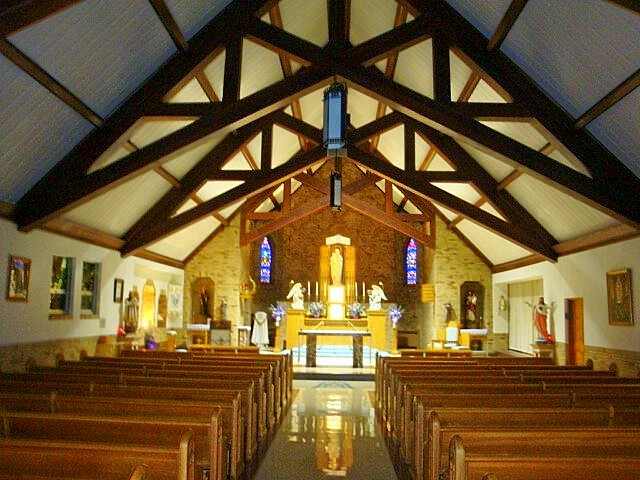 held four times a day in the chapel for those who wish for more than just individual reflection on site. Pilgrims testify to the extraordinary qualities of the site: “’It’s incredible — she’s here, you just feel it’, Ms. Banda said after praying in the crypt chapel, said to be on the spot of the apparitions. As they passed a statue of Mary in white, just as described by Ms. Brise, Ms. Banda was overcome with emotion, weeping and hugging her mother. The two of them went back to pray some more” (Eckholm 2010). Another pilgrim stated that “There’s a lot of power here….You can feel the presence of Mary, and it feels like she’s listening to you” (Eckholm 2010). Many crutches and canes are left behind at the shrine’s crypt. The owners of these items leave them saying that they no longer need their assistance.
held four times a day in the chapel for those who wish for more than just individual reflection on site. Pilgrims testify to the extraordinary qualities of the site: “’It’s incredible — she’s here, you just feel it’, Ms. Banda said after praying in the crypt chapel, said to be on the spot of the apparitions. As they passed a statue of Mary in white, just as described by Ms. Brise, Ms. Banda was overcome with emotion, weeping and hugging her mother. The two of them went back to pray some more” (Eckholm 2010). Another pilgrim stated that “There’s a lot of power here….You can feel the presence of Mary, and it feels like she’s listening to you” (Eckholm 2010). Many crutches and canes are left behind at the shrine’s crypt. The owners of these items leave them saying that they no longer need their assistance.
Every year, there are different events to honor the site and the Virgin Mary. On October 8, pilgrims gather to repeat the procession of the grounds that began during the Peshtigo fire. In May, there is an annual outdoor Mass that includes another procession to the chapel grounds. This tradition was founded by Norbertine Fr. Bernard Pennings in 1895 (Kasten 2010). Finally, an extremely popular tradition is the annual Mass on the feast of Assumption. This event takes place on August 15 and, from morning until night, cars can be seen lining up at the shrine.
ORGANIZATION/LEADERSHIP
Within days of Brise’s final vision in 1859, her father, Lambert Brise, built a small ten by twelve foot chapel at the apparition site. The chapel was enlarged to twenty four by forty feet in 1861; a third chapel of brick construction was erected in 1880.
Following the instructions she received from Mary in 1859, Brise, at age twenty eight, began teaching the Catholic faith to all the children that she could reach. Several young women joined her to form “a community of Third Order (secular) Franciscans” and found St. Mary’s Academy in 1869 (Shrine 2010). The small group of children eventually grew to be the ninety-five children. Brise received no formal funding for this school, instead relying on donations. At times she even had to beg for supplies and funds for the school. Brise remained resolute in her mission until her death in 1896.
Unfortunately, without the Brise’s presence, the leadership at the school faltered. For a time the school was placed in the care of Sr. Pauline LaPlante. LaPlante was one of the community’s original members, and she ran the school with nearly the same devotion as Brise had from 1902 until her death in 1926. At that time the school was altered on several occasions. It became a home for crippled children in 1933, a pre-noviate high school for the Bay Settlement Sisters in 1953, and, finally, a site for the Carmel of the Holy Name of Jesus in 1992. After the Carmelite sisters moved on in 2002, the site was restored to a chapel and shrine dedicated to the apparitions that Brise had encountered over 150 years earlier (Kasten 2010). Although the site had received informal support from local bishops through its history as a pilgrimage and prayer site, it was not formally validated until 2009 when Bishop David Ricken commissioned an investigation into the authenticity of the original apparitions. Over the next two years theologians examined the available historical documents: “We had written testimonies, some oral testimonies – written down later, plus a lot of documentation – letters between Sister Adele and the bishop, etc,
Bishop Ricken realls” (Kim 2011).
Less than two years later, Ricken stated with certainty that the site could indeed be validated as a supernatural and religious site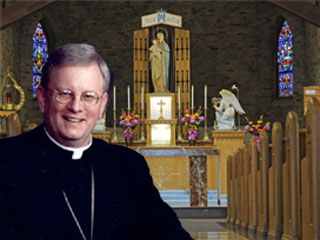 (“Wisconsin Site” 2011). He stated that “I declare with moral certainty and in accord with the norms of the Church that the events, apparitions and locutions given to Adele Brise in October of 1859 do exhibit the substance of supernatural character, and I do hereby approve these apparitions as worthy of belief (although not obligatory) by the Christian faithful” (“Marian Apparitions” 2010).
(“Wisconsin Site” 2011). He stated that “I declare with moral certainty and in accord with the norms of the Church that the events, apparitions and locutions given to Adele Brise in October of 1859 do exhibit the substance of supernatural character, and I do hereby approve these apparitions as worthy of belief (although not obligatory) by the Christian faithful” (“Marian Apparitions” 2010).
ISSUES/CHALLENGES
From the beginning, Brise received little help or recognition. Her father built the original shrine on the spot of the apparitions himself. Brise also was alone in starting her school and helping the local children. St. Mary’s academy, a boarding school, was built in 1867. Within five years there were almost a hundred students enrolled. She relied heavily on her faith and the few donations she received. At times, when the school was low on funding and in need of supplies, Brise would go beg to get the money they needed. After Brise died, the meager support that was once there dwindled and faded.
The school and grounds passed from hand to hand until finally, in 2009, Bishop David Ricken launched an investigation into the authenticity of the apparition site. Before the site was investigated, thirty to fifty people a day would make the journey to Our Lady of Good Help (Keen 2011). However, once Bishop Ricken announced that the site was “approved” and “worthy of belief by the Christian faithful,” that number skyrocketed to around 500 people a day (Mann 2010). With the increased visitation, two priests were assigned full time to the shrine (Keen 2011).
There have been suspicions expressed in the press that the diocese’s investigation was timed to redirect attention away from the priest sex abuse cases that were then plaguing the Catholic Church. Bishop Ricken responded to these allegations: “People have a hunger for the spiritual, and right here in our backyard was a source to meet that need.” He went on to express an expectation that the shrine would become a source of hope and healing (Eckholm 2010). Whatever the merits of the suspicions and allegations, Bishop Ricken’s declaration of “moral certainty” has brought new life and recognition to Our Lady of Good Help (“Wisconsin Site” 2011).
REFERENCES
Eckholm, Erik. 2010. “ Wisconsin on the Map to Pray With Mary.” New York Times , December 23. Accessed from http://www.nytimes.com/2010/12/24/us/24mary.html?_r=0 on 22 November 2013.
Kasten, Patricia. 2010. “Guided by Mary, Adele Brise Taught Children about Catholic Faith.” The Compass , December 9. Accessed from http://www.thecompassnews.org/news/local/1794-guided-by-mary-adele-brise-taught-children-about-catholic-faith.html on 31 October 2013.
Keen, Judy. 2011. “Faithful Trek to Wisconsin Shrine.” USA Today , September 22. Accessed from http://usatoday30.usatoday.com/news/religion/story/2011-09-22/wisconsin-virgin-mary-shrine/50519566/1 on 20 November 2013 .
Kim, Susan. 2011. “Official Holy Site Near Green Bay.” Accessed from http://www.google.com/url?sa=t&rct=j&q=&esrc=s&source=web&cd=1&ved=0CCwQFjAA&url=http%3A%2F%2Fwww.620wtmj.com%2Fnews%2Flocal%2F115996504.html&ei=yLeSUp6YI4uikQeCqoGICg&usg=AFQjCNET9GWym9VHvgT10dawcHCxTLnUIg&sig2=STdBrHBGxoAfK1eyI4km1w&bvm=bv.56988011,d.eW0 on 22 November 2013.
Mann, Benjamin. 2010. “Wisconsin Chapel Approved as First U.S. Marian Apparition Site.” Catholic News Agency ., December 9. . Web. 01 Nov 2013.
“Marian Apparitions at Shrine of Our Lady of Good Help Approved by Bishop Ricken.” 2010. DA MIHI ANIMAS , December 8. Accessed from http://salesianity.blogspot.com/2010/12/marian-apparitions-at-shrine-of-our.html on 20 November 2013.
Shrine of Our Lady of Good Hope. 2010. “A Brief Historical Account.” Accessed from http://www.gbdioc.org/images/stories/Evangelization_Worship/Shrine/Documents/Shrine-History-Brief.pdf on 28 November 2013.
Sly, Randy. 2010. “The Shrine of Our Lady of Good Help Receives the Decree from Bishop of Green Bay.” Catholic Online . December 11. Accessed from http://www.catholic.org/hf/faith/story.php?id=39511 on 01 November 2013.
“Wisconsin Site Deemed ‘Holy’ by Catholic Leaders.” 2011. Seattle Times , February 14. Accessed from http://seattletimes.com/html/nationworld/2014222320_apusholysitegreenbay.html on 20 November 2013.
Authors:
David G. Bromley
Caitlin St. Clair
Post Date:
1 December 2013
